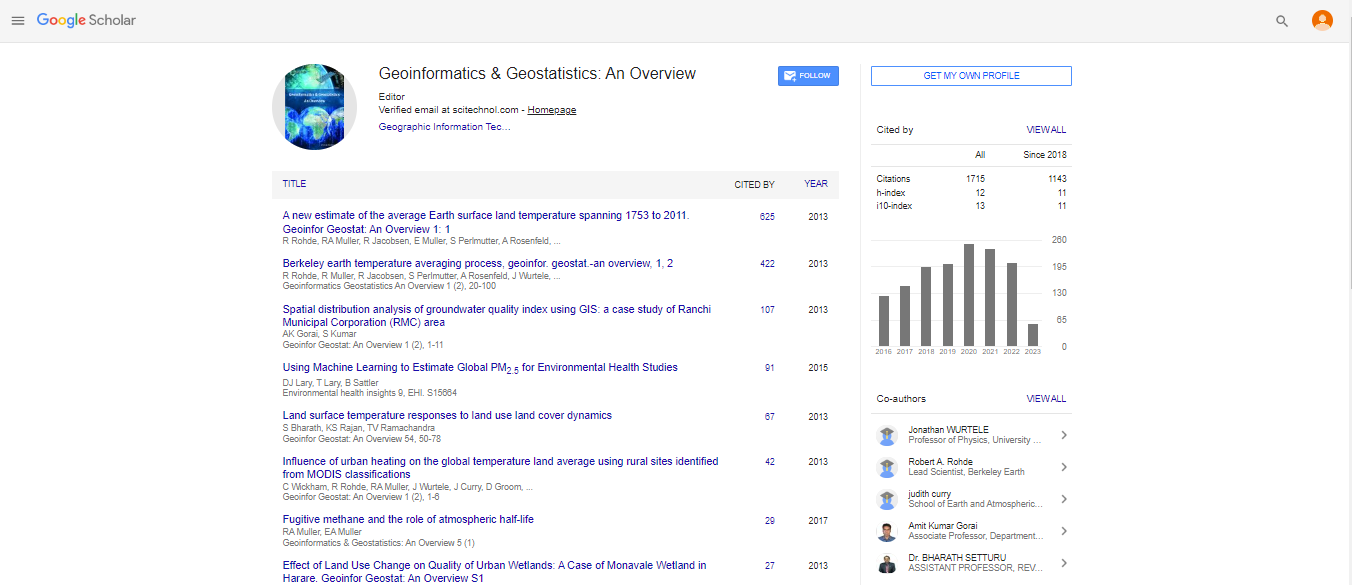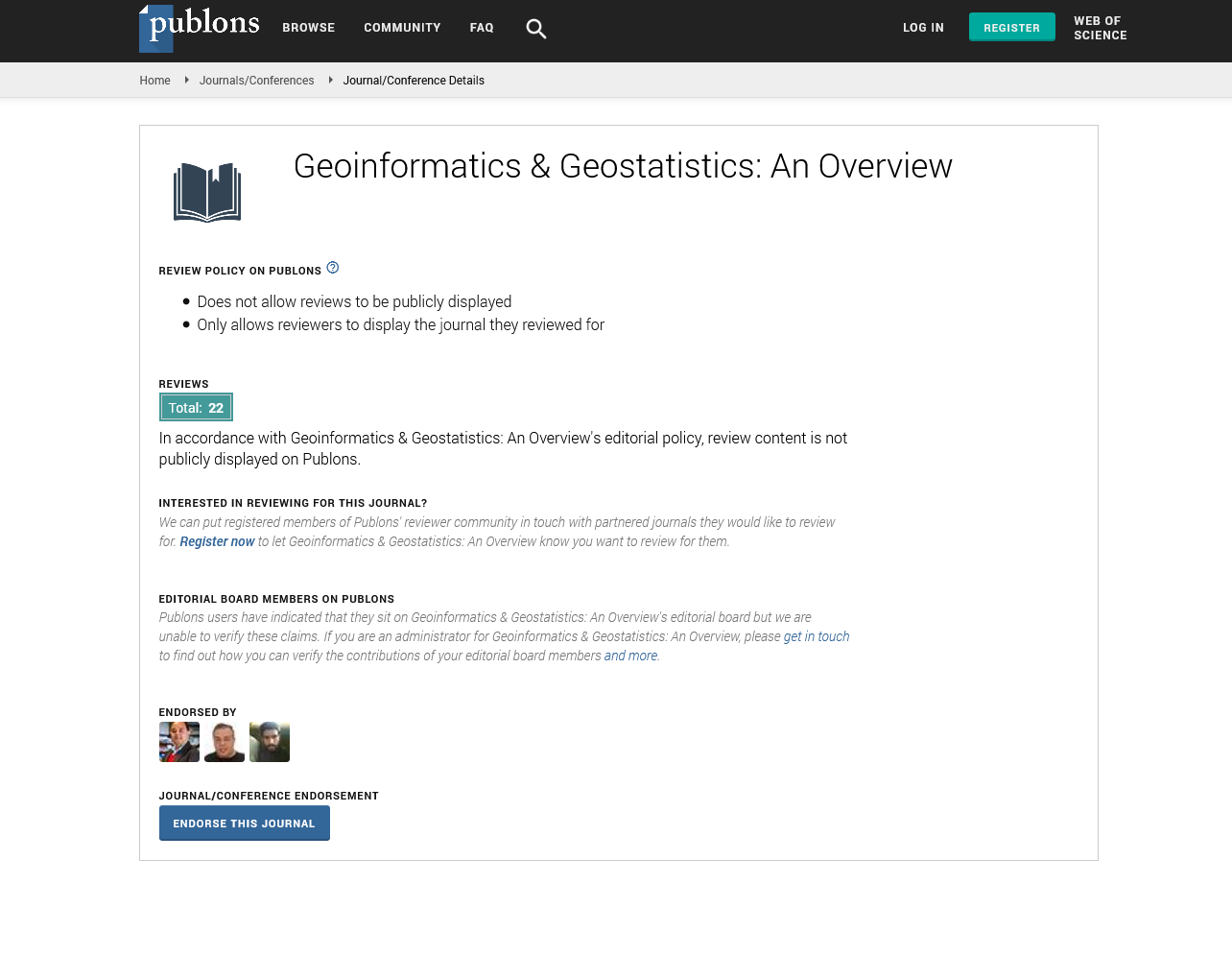Commentary, Geoinfor Geostat An Overview Vol: 12 Issue: 6
Digital Mapping in Environmental Monitoring: Applications and Insights
Mishu Ali*
1Deparment of Geography, University of the Witwatersrand, Johannesburg, South Africa
*Corresponding Author: Mishu Ali,
Deparment of Geography, University of the
Witwatersrand, Johannesburg, South Africa
E-mail: ali_m@witsac.za
Received date: 29 November, 2024, Manuscript No. GIGS-24-156231;
Editor assigned date: 02 December, 2024, PreQC No. GIGS-24-156231(PQ);
Reviewed date: 16 December, 2024, QC No. GIGS-24-156231;
Revised date: 23 December, 2024, Manuscript No. GIGS-24-156231(R);
Published date: 30 December, 2024, DOI: 10.4172/2327-4581.1000426.
Citation: Ali M (2024) Digital Mapping in Environmental Monitoring: Applications and Insights. Geoinfor Geostat: An Overview 12:6.
Description
Digital mapping has become a transformative tool for representing and analyzing spatial data, revolutionizing industries ranging from urban planning to environmental conservation. This technology integrates various data sources, such as satellite imagery, GPS coordinates and field surveys, into a comprehensive digital format, allowing for dynamic and interactive maps. Unlike traditional cartography, which is static and limited in its ability to be updated, digital maps offer real-time data integration, enabling users to engage with and interpret geographical information in ways that were previously unimaginable.
The process of digital mapping begins with data collection, which can come from a variety of sources. Remote sensing technologies, such as satellites and drones, capture high-resolution images of the Earth's surface, while GPS devices provide precise location data. Crowdsourcing, where individuals contribute their own spatial data through platforms like OpenStreetMap, has also become an essential component in creating up-to-date and accurate maps. Once this data is collected, it is processed using Geographic Information Systems (GIS) software. GIS tools help to refine raw data, correcting inaccuracies and ensuring that the information is both consistent and reliable. This data processing includes geo-referencing, which aligns the data to a map projection interpolation, which fills in gaps where data may be missing.
One of the defining features of digital mapping is its ability to visualize data in a variety of forms. While traditional maps are limited to flat representations, digital maps offer a range of visualization tools, such as 3D modeling, heat maps and Augmented Reality (AR). These interactive visualizations allow users to explore data in real time, making it easier to interpret complex spatial information. For example, in urban planning, GIS-based zoning can help planners design infrastructure projects, optimize land use predict future population growth. In transportation, real-time digital maps assist with route planning, traffic management fleet coordination, while also providing valuable information for individuals navigating city streets.
Digital mapping is particularly invaluable in the field of disaster management. By providing real-time, high-resolution maps of affected areas, it enables rapid response and more effective resource allocation. These maps are essential in identifying high-risk zones, tracking the progression of natural disasters guiding rescue operations. Similarly, environmental monitoring benefits from digital mapping, where it plays an important role in tracking climate change, managing wildlife habitats assessing deforestation. These maps help conservationists understand environmental shifts and make informed decisions for sustainable management.
Despite the many advantages digital mapping offers, it also faces several challenges. One of the primary concerns is data privacy and security, as the collection and sharing of geospatial data can expose sensitive information. Additionally, the cost of implementing digital mapping technologies can be prohibitive for many organizations, especially when advanced hardware, software specialized personnel are required. Accuracy is another issue, as outdated or inconsistent data can lead to unreliable maps that undermine the decision-making process.
Looking ahead, the future of digital mapping is closely tied to the development of emerging technologies. Artificial Intelligence (AI) has the potential to automate data updates, improve predictive modeling enhance the analysis of spatial data. Block-chain technology could provide more secure and transparent ways to share and verify geospatial information, development trust in collaborative representing efforts. The Internet of Things (IoT) is also set to play a significant role in digital mapping, as devices connected to the internet provide real-time data that can be incorporated into maps for applications such as smart cities and connected transportation networks.
In conclusion, digital mapping has become a vital tool for understanding and interacting with spatial data. Its applications span a wide range of sectors, from urban planning and transportation to disaster response and environmental conservation. As technology continues to advance, digital mapping will change, becoming even more integrated into our daily lives and new opportunities for innovation and problem-solving. Despite its challenges, the future of digital mapping aspects favorable, with emerging technologies poised to further enhance its capabilities and impact.
 Spanish
Spanish  Chinese
Chinese  Russian
Russian  German
German  French
French  Japanese
Japanese  Portuguese
Portuguese  Hindi
Hindi 
